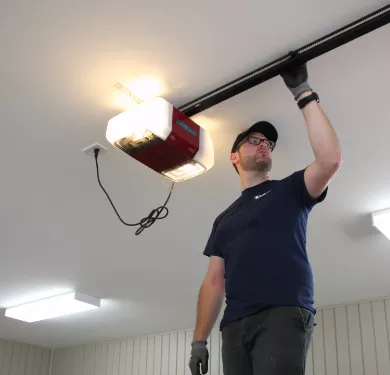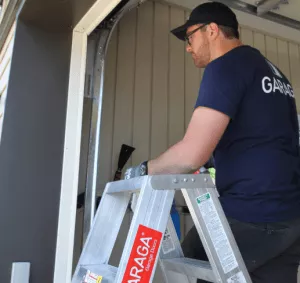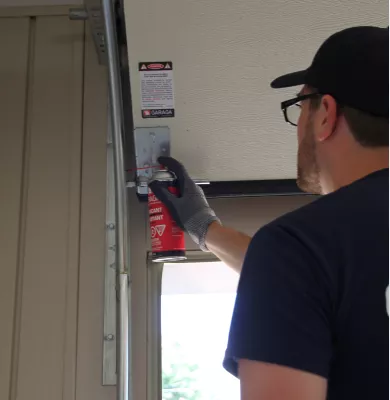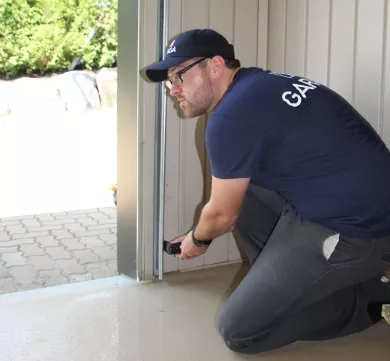If you have a garage door, it needs routine maintenance.
Neglecting your door could create a host of problems, just as putting off a small ache or pain could turn into bigger issues when you finally visit the doctor.
In the end, you’ll end up spending far more on resolving the problems than if you would have taken care of things right away.
Your garage door is the largest and probably the heaviest moving piece of equipment in your home. Even if you only use your door on occasion, it still needs regular maintenance and inspections for everyone’s safety and peace of mind.

Safety first!
Many incidents happen with garage doors that malfunction every single year.
In 2014 alone, the US saw more than 18,000 accidents related to malfunctioning or broken garage doors.
The causes?
Usually, there was one of 3 issues to blame: component failure (such as a broken extension spring), an imbalanced door, or an improperly calibrated automatic reversal system.
The latter could be mechanical or electrical in nature.
Set a schedule for garage door inspections
The solution for almost all of these situations is fairly easy: inspect the garage door regularly.
With all of the technology out there, it’s easy to set a reminder for twice per year to take a look at your garage door and all of its components to make sure that everything is in working order.
The inspection will take about 30 minutes or less, and it just requires you looking around to spot signs of trouble. Make sure that you test the safety of the automatic reverse systems and lubricate all the necessary parts.
Break it down...
You should perform an inspection in the spring and fall. If you use your door more frequently, you may want to check it every few months instead. When you do your inspection, here’s what you need to cover.
Visual/Audible Inspection
Look at, and listen to, your garage door. Open and close the door. Listen for noises that you aren’t supposed to hear or louder‑than‑normal operation. Also, check the lift cables for frays or knots, and check to see that everything is wound properly along the drum. If you follow the system with your eyes, it should be easy to check every part of the door to ensure that it’s in working order.
Next, you’ll need to look at the spring system. As long as they are not making any excessive or unusual noises, and the springs don’t appear broken or close to the breaking point, you should be fine. Keep in mind, there are two types of spring systems you will encounter:
Extension springs, which are located over the top of the tracks.
Torsion springs, which are placed over the top of the door in a shaft.

Next, look at the rollers on the door. Are they in good working order? Are there any flat spots on the rollers or do they need a little lubrication? Check the hinges, too. Look for loose screws or bolts and brackets that may be worn, cracked, or have come loose.
Make sure that the weatherstripping on your garage door is in good shape to keep all of the moisture, pests, and other nuisances out of your garage. Finally, make sure that you check the photoelectric reversal sensors and system for obstructions and proper operation.
Lubricate your door
There are two types of lubricants used on garage doors. Metal parts require the use of a 5W30 motor oil (for car engines) while the weatherstripping requires a silicone‑based lubricant. The latter will be applied at the bottom of the door, around the frame, and between sections. You can purchase both lubricants at DSI North Door Systems.
Also, make sure that you clean everything prior to lubricating. This includes removing old oil or grease that was applied previously and has not worn away.

For metal parts, you can add a little oil with a cloth on the following areas:
- The spring system
- The ball bearings of the rollers
- Hinges
- Curves of the door track and the horizontal track
Weatherstripping that needs lubricated includes:
- The entire interior edge that surrounds the exterior frame of the door
- Between the door panel sections, and especially those with PVC weatherstripping
- At the bottom of the door, including on all sides of the u‑shaped strip¸
Time to check for safety
You need to test the automatic reverse systems if your garage door has an electric opener. Many manufacturers even recommend that these systems be tested as often as monthly.
For the 1st test, lay a spare piece of wood on the threshold of the garage while the door is open. Press the button to close the door. When it hits the wood, it should reverse and open again.
The 2nd test checks the function of the sensors. Close the door with a remote. While it is closing, block the sensor at the base of the door with your foot. This should interrupt the light beam, causing the door to reverse safely to avoid crushing something or someone.

If either system does not function properly, you need to contact DSI North Door Systems immediately for service.
This simple maintenance will help improve the lifespan of your garage door and keep any unexpected surprises and repairs at bay. In the event that you eventually need garage door repair, proper maintenance can go a long way in saving you money on professional garage door technician labor costs and required work.
No time to spare?
We live in a busy world, and most people don’t have time for one more thing to do. The garage is often forgotten because it is not a room in the home, but it needs a little TLC. If you’re not up to the task or you just don’t have the time, let us help.
You can contact us at 1-800-425-0662 to discuss your needs. We offer everything from affordable tune‑ups and maintenance to full replacements, so if you’re thinking about an upgrade, we can give you a quote for that, as well.

Add new comment